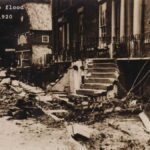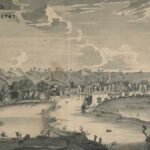Glimpse history through old images of Harlaxton Manor, five miles from Grantham, in the county of Lincolnshire, England.
Harlaxton Manor in 1939
This footage from 1939 shows Harlaxton Hall’s gardens and interior.
At the time it belonged to businesswoman and inventor Mrs Van der Elst, who bought it in 1937 and renamed it Grantham Castle. She spent much of the personal fortune she had amassed in renovating the 150 rooms of her new home.
However, World War II started. In 1942 and 1943, the 1st Battalion of the British Airborne Division was in residence.
In 1948, Mrs Van der Elst sold the house and 500 acres to The Society of Jesus – the Jesuits – as a novice centre, and auctioned the huge collection of contents.
Since Grantham Castle was a wooden Norman construction lost centuries ago, Harlaxton Manor was given back its original name.
“Grantham Castle” – Harlaxton Manor (1939) – British Pathé (YouTube)
A bit of Harlaxton Manor history
Extract from: A selection of Views in the county of Lincoln, by Bartholomew Howlett
Published in 1801
HARLAXTON is a village three miles south – west from Grantham: a spring, the source of the small river Mowbeck, rises in the village, through which it runs in its course to the river Witham, into which it falls on the north side of Grantham.
The lordship of Harlaxton contains about two thousand four hundred acres: George de Ligne Gregory is Lord of the Manor, and the greatest proprietor.
The parish is a Rectory, of the yearly value of about £400, in the patronage of the Church of Salisbury. The Reverend Henry Dodwell is the present Rector.
The church of Harlaxton is large, for a village, hath a spire, and a spacious chancel with three aisles.
The canal from Nottingham to Grantham goes through this lordship; there is also a turnpike – road from Leicester, through Melton Mowbray to Grantham, which passes through the lordship of Harlaxton, very near to the village.
The manor and principal property in the lordship of Harlaxton, was, in the reign of King Henry VII. possessed by the family of Blewitt, and was afterwards purchased by Sir Daniel de Ligne, a Fleming of great property; who, with other opulent inhabitants of the Netherlands, took refuge in England, to avoid the persecutions against the Protestants by King Philip II. of Spain.
Sir Daniel de Ligne not only purchased the greatest part of the lordship of Harlaxton, but the lordship of Stonesby, in the county of Leicester, with other estates in Norfolk, and in the city of London, and elsewhere.
The situation of the Manor – house is low, being at the foot of the high hills in front of it; from the summits of which are very extensive prospects, to the north and west, over a considerable part of the counties of Lincoln, Nottingham, Leicester, and Derby.
The garden, in the south front of the Manor – house, is surrounded with a deep and wide moat, filled with water, with a bridge over it; and the outer court ( the entrance into which is through an arched stone gateway with double doors ) in the north front, is surrounded with a high terrace, or mount of earth, planted with trees.
The outer and inner courts are separated by a very beautiful Gothic balustrade of stone, with double iron gates in the centre.
The Manor – house, a very extensive pile of building of stone, two hundred and thirty – six feet in front, is very ancient, and hath a venerable and noble appearance.
Sir Daniel de Ligne made very considerable additions to it, and greatly enlarged it: he built the long gallery, one hundred and nine feet in length, fourteen feet eight inches wide, and eleven feet two inches high, which, with the great dining – room, forty – four feet in length, and thirty – one feet wide, he fitted up with great expense, in a noble style, ornamenting the windows of both these rooms with very beautiful and valuable painted glass, the subjects of which are various: some represent remarkable events in the Roman history; others, are scriptural; others, emblematical, & c. In the bow – window in the great dining – room, are the coats of arms of De Ligne, De La Fountaine, De Cordes, and other relatives of the De Ligne family, who all emigrated together from the Netherlands at the same period, and purchasing estates in England, not far distant from each other, became residents here.
More about Lincolnshire
- Old Images of Lincolnshire, England
- Old Images of Louth, Lincolnshire
- Old Images of Immingham, Lincolnshire
- Old Images of Grantham, Lincolnshire
- Old Images of Gainsborough, Lincolnshire
- Old Images of Crowland, Lincolnshire
- Old Images of Boston, Lincolnshire
- Old Images of Scunthorpe, Lincolnshire
- Old Images of Harlaxton Manor, Lincolnshire
- Old Images of Spalding, Lincolnshire
- Old Images of Skegness, Lincolnshire
- Old Images of Scampton, Lincolnshire
- Old images of Cranwell, Lincolnshire
- Old Images of Sleaford, Lincolnshire
- Old Images of Horncastle, Lincolnshire
- Old Images of Stamford, Lincolnshire
- Old images of Keadby Bridge, Lincolnshire
- Old Images of Mablethorpe, Lincolnshire
- History in Old Images of Lincoln, UK
- Old Images of Ruskington, Lincolnshire





















